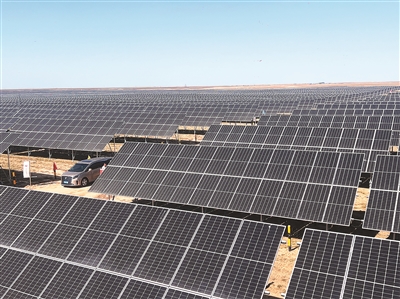




- BRNN
- BRI News
- BRNN News
- Database
Official Documents Polices and Regulations
Inter-government Documents International Cooperation BRI Countries
Business Guide Economic Data BRI Data
Trade
Investment Projects Latest projects
Cases - Content Pool
China's largest standalone solar power station built in a coal mining subsidence zone was connected to the grid for power generation in Otog Front Banner, Ordos city, north China's Inner Mongolia Autonomous Region on Nov. 5, 2024.
The massive photovoltaic (PV) power station spanning approximately 105,000 mu (7,000 hectares) was included in the country's second batch of large wind power and PV bases in sandy areas, rocky areas and deserts.

Photo shows China's largest standalone solar power station built in a coal mining subsidence zone in Otog Front Banner, Ordos city, north China's Inner Mongolia Autonomous Region. (People's Daily Overseas Edition/Liao Ruiling)
Comprising over 5.9 million solar panels, the solar powerhouse has an installed capacity of 3 million kilowatts and spans an area equivalent to 10,000 standard football fields, according to Li Jinyuan, project manager of a subsidiary of GD Power Development Co., Ltd. under CHN Energy.
The solar power station is situated in the heart of the Mu Us Desert with abundant renewable energy resources at the junction of three provincial regions.
Li said that the solar power station serves a dual purpose - harnessing clean energy while contributing to ecological restoration.
"The solar panels provide shade, significantly reducing water evaporation from the desert soil. Meanwhile, the water we use to clean the panels seeps into the ground, which helps vegetation thrive," Li added.
The solar power station stands out for its innovative approach to environmental protection. The proportion of steel materials accounts for 99 percent of all materials used in the pile foundation for PV brackets, Li said, adding that this reduces the environmental footprint by decreasing the foundation diameter from 400mm to 100mm.
In addition, plants like alfalfa are grown beneath the panels, facilitating ecological restoration while helping herdsmen earn additional income by leasing their land.
"As the project is located in a coal mining subsidence zone, it is necessary to give full consideration to how to adapt to the local geological conditions and design innovative PV components," said Chuang Xihong, deputy director of the construction department of GD Power Development Co., Ltd.
The power station features flexible PV brackets that can automatically accommodate ground subsidence and uses satellite technology for continuous monitoring, said Yang Bin, a researcher with CHN Energy New Energy Technology Research Institute Co., Ltd., adding that this ensures stable operation despite the challenging terrain.
As an important part of China's west-to-east power transmission program, the PV power station is projected to generate 5.7 billion kilowatt-hours of electricity annually. The green power generated will be transmitted to east China's Shandong Province and is poised to meet the annual residential demands of 2 million households.

Tel:86-10-65363107, 86-10-65368220, 86-10-65363106